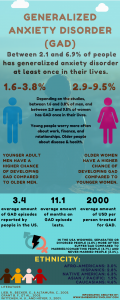Diagnosing generalized anxiety disorder according to the DSM-IV-TR
Recognizing symptoms of generalized anxiety disorder (GAD) in yourself or your friend is not enough for the diagnosis of generalized anxiety disorder. General practitioners, psychiatrists, and psychologists use internationally established criteria for diagnosing generalized anxiety disorder. Next to suffering from a minimum amount of GAD symptoms, it’s also important to consider the amount of time you had these GAD symptoms and possible other mental or physical disorders that could explain the generalized anxiety symptoms. Of the people with GAD, 60.5% have a comorbid condition, such as another anxiety disorder, mood disorder or personality disorder [1].
Sometimes professionals miss the diagnosis of GAD because its symptoms show a lot of overlap with the symptoms of other disorders, such as Major Depressive Disorder. At Barends Psychology Practice, diagnosing generalized anxiety disorder is possible and for that purpose the DSM-IV-TR criteria are used. The DSM IV is an internationally used classification system and stands for Diagnostic and Statistical Manual of Mental Disorders. The IV indicates that it is the fourth edition, the TR stands for Text-Revised, which means that the Manual has been updated.
Jump to:
- What is generalized anxiety disorder and what are the symptoms.
- Generalized anxiety disorder causes.
- Generalized anxiety disorder treatment.
- Coping with generalized anxiety disorder yourself.
- Living with someone who has generalized anxiety disorder.
- Generalized anxiety disorder test.
- Interesting generalized anxiety disorder facts
- Online counseling for generalized anxiety disorder.
- Take me to the homepage.
At Barends Psychology Practice we offer (online) therapy for generalized anxiety disorder. Contact us to schedule a first, free of charge, online session. (Depending on your health insurance, treatment may be reimbursed).
Diagnosing generalized anxiety disorder – the criteria
According to the DSM-IV-TR someone needs to meet the following criteria for a generalized anxiety diagnosis:
A. Excessive anxiety and worry, occurring most of the days for at least 6 months, about several events or activities (think of work or school performance).
B. Difficulty to control the worry.
C. The worry and anxiety are associated with at least three of the following symptoms. Some of these symptoms must be present most of the days for the past 6 months:
- Restlessness or feeling keyed up or on edge.
- Being easily fatigued.
- Difficulty concentrating or mind going blank.
- Irritability.
- Muscle tension.
- Sleep disturbance (difficulty falling or staying asleep, or restless unsatisfying sleep).
(Advertisement. For more information, please scroll down.)
D. The focus of the anxiety and worry can not be explained by other mental issues/disorders, such as:
- about having a panic attack (panic disorder).
- about being embarrassed in public (social phobia).
- about being contaminated (obsessive-compulsive disorder).
- about being separated from home or family (separation anxiety disorder).
- about gaining weight (anorexia nervosa).
- about having multiple physical complaints (somatic symptom disorder).
- about having a serious illness (hypochondriasis).
- and are not related to Post-traumatic stress disorder.
E. The anxiety, worry, or physical symptoms cause clinically significant distress or impairment in social, occupational, or other important areas of functioning.
F. The disturbance is not due to the direct physiological effects of a substance (e.g., drug abuse or a medication) or a general medical condition (e.g., hyperthyroidism) and does not occur exclusively during a Mood Disorder, a Psychotic Disorder, or a Pervasive Developmental Disorder.
(Advertisement. For more information, please scroll down.)

